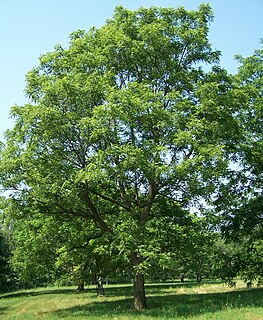
Walnut trees are any species of tree in the plant genus Juglans, the type genus of the family Juglandaceae, the seeds of which are referred to as walnuts. All species are deciduous trees, 10–40 metres (33–131 ft) tall, with pinnate leaves 200–900 millimetres (7.9–35.4 in), with 5–25 leaflets; the shoots have chambered pith, a character shared with the wingnuts (Pterocarya), but not the hickories (Carya) in the same family.
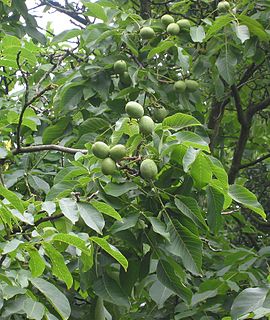
The Juglandaceae are a plant family known as the walnut family. They are trees, or sometimes shrubs, in the order Fagales. Members of this family are native to the Americas, Eurasia, and Southeast Asia.

Juglans nigra, the eastern American black walnut, is a species of deciduous tree in the walnut family, Juglandaceae, native to North America. It grows mostly in riparian zones, from southern Ontario, west to southeast South Dakota, south to Georgia, northern Florida and southwest to central Texas. Wild trees in the upper Ottawa Valley may be an isolated native population or may have derived from planted trees.
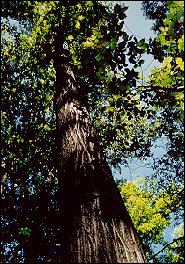
Juglans cinerea, commonly known as butternut or white walnut, is a species of walnut native to the eastern United States and southeast Canada.

Juglans regia, the Persian walnut, English walnut, Carpathian walnut, Madeira walnut, or especially in Great Britain, common walnut, is an Old World walnut tree species native to the region stretching from the Balkans eastward to the Himalayas and southwest China. It is widely cultivated across Europe.
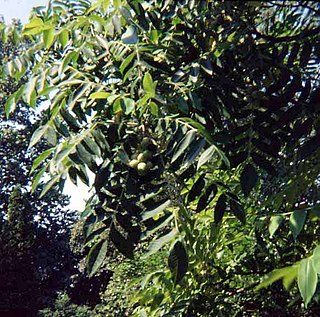
Juglans ailantifolia, the Japanese walnut, is a species of walnut native to Japan and Sakhalin. It is a deciduous tree growing to 20 m (66 ft) tall, rarely 30 m (98 ft), and 40–80 cm stem diameter, with light grey bark. The leaves are pinnate, 50–90 cm long, with 11-17 leaflets, each leaflet 7–16 cm long and 3–5 cm broad. The whole leaf is downy-pubescent, and a somewhat brighter, yellower green than many other tree leaves. The male flowers are inconspicuous yellow-green catkins produced in spring at the same time as the new leaves appear. The female flowers have pink/ red pistils. The fruit is a nut, produced in bunches of 4-10 together; the nut is spherical, 3–5 cm long and broad, surrounded by a green husk before maturity in mid autumn.

Juglans californica, the California black walnut, also called the California walnut, or the Southern California black walnut, is a large shrub or small tree of the walnut family, Juglandaceae, endemic to California.

Juglans mandshurica, also known as Manchurian walnut, is a deciduous tree of the genus Juglans, native to the Eastern Asiatic Region. It grows to about 25 m.
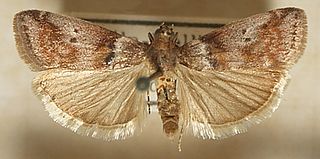
Acrobasis consociella is a moth of the family Pyralidae. It is found in Europe.

Juglans hindsii, commonly called the Northern California walnut and Hinds' black walnut, is a species of walnut tree endemic to Northern California. It is commonly called claro walnut by the lumber industry and woodworkers, and is the subject of some confusion over its being the root stock for English walnut orchard stock.

Acrobasis is a genus of moths of the family Pyralidae.
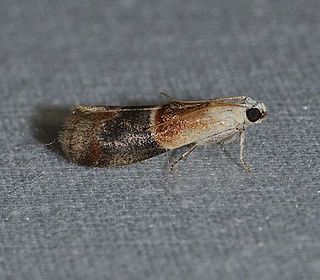
Acrobasis demotella, the walnut shoot moth, is a moth of the family Pyralidae described by Augustus Radcliffe Grote in 1881. It is found in North America, from Ontario south to North Carolina and west to Missouri and Michigan.

Acrobasis caryivorella, the pecan nursery casemaker, is a species of snout moth in the genus Acrobasis. It was described by Émile Louis Ragonot in 1887, and is known from southeastern Ontario, Canada, and the eastern United States.
Acrobasis latifasciella is a species of snout moth in the genus Acrobasis. It was described by Harrison Gray Dyar Jr., in 1908, and is known from the northeastern United States.
Acrobasis juglanivorella is a species of snout moth in the genus Acrobasis. It was described by Herbert H. Neunzig in 1986, and is known from Wisconsin, United States.

Acrobasis tricolorella, the destructive prune worm or tricolored acrobasis moth, is a species of snout moth in the genus Acrobasis. It was described by Augustus Radcliffe Grote in 1878, and is known from southern Canada and northern United States.
Acrobasis obtusella is a species of snout moth in the genus Acrobasis. It was described by Jacob Hübner in 1796. It is found in most of Europe.
Acrobasis bithynella is a species of snout moth in the genus Acrobasis. It was described by Philipp Christoph Zeller in 1848, and is known from France, the Iberian Peninsula, Italy, Croatia, Crete, Turkey and Russia.

Acrobasis advenella is a species of snout moth in the genus Acrobasis. It was described by Johann Zincken in 1818 and is found in most of Europe.
Acrobasis legatea is a species of snout moth in the genus Acrobasis. It was described by Adrian Hardy Haworth in 1811. It is found in most of Europe, except the north, east to Russia and Kazakhstan.
















